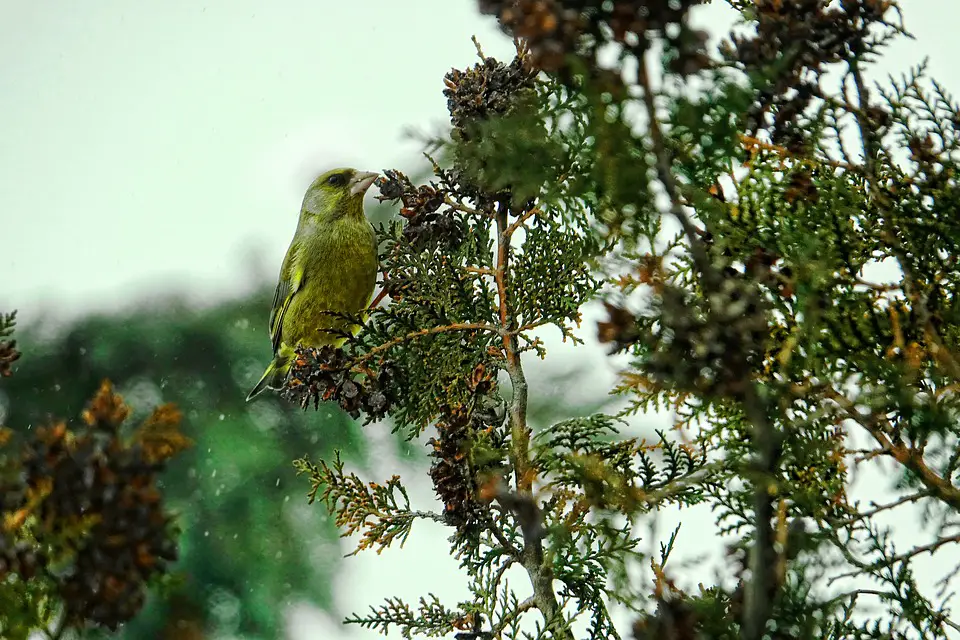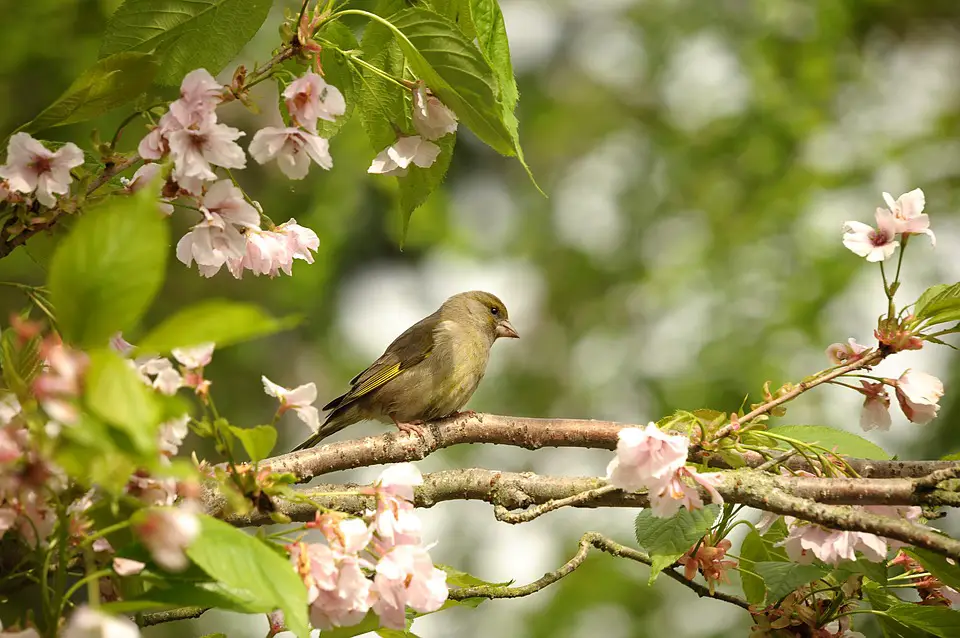The greenfinch is one of my favourite garden birds. Not just because of its instantly recognisable colouring or its pretty chirruping, but mostly because he is such an easily pleased little fella.
They are small birds, about the size of a house sparrow. Their numbers dramatically decreased in 2005 due to a nasty bout of trichomonosis. Gladly, they are back on the rise now and there are just shy of 2 million breeding pairs in Britain.
It is quite common to see them nesting in a conifer in your garden or eating from a bird table. Once we know what do greenfinches eat, we can offer an array from foods to entice them back regularly.
Greenfinches in the wild rely on mostly seeds and berries for their diet, though they are omnivorous and will supplement that with an insect or 2.
They will happily eat seeds from a bird table, even one that is covered. They don’t mind feeding on the ground either so if your garden is predator-free, feel free to sprinkle some seeds in a little open space.
They are always on the lookout for sunflower seeds, hearts are great for them but they don’t mind cracking the shells of the black seeds.
Growing sunflowers in the garden not only adds some summery brightness but is also a valuable feeding resource for many birds, including greenfinches.
Greenfinches in the Wild

Seeds
They have strong beaks that they use to prise seeds from their pods, they will try most seeds that are available. In the autumn they love the seeds of the yew and hawthorn, and in winter they look for brambles. Sunflower seeds are their absolute favourites.
Buds
They are always on the lookout for new buds and shoots. Packed with nutrients they are a nice variation to a mostly seed diet. Lavender and dandelions will attract them.
Insects
You will mostly find the greenfinch foraging for insects during the breeding season. This is because they are protein-packed and essential for the health and growth of fledgeling birds. They usually plump for beetles and their larvae though no small,soft-bellied insect is off the menu.
Greenfinches in the Garden

If you’re trying to attract greenfinches to your garden, or just keep the ones happy who already frequent it, here are some ideas.
Sunflower hearts
The greenfinch can easily break into a sunflower seed and discard the outer shell, it has a strong, slightly hooked beak specifically for this job. I prefer to offer the hearts purely from an aesthetic point of view, it creates less mess!
Niger seeds
These tiny black seeds are the nectar of many small garden birds as they are easy to digest, carry, and have high nutritional value.
Their high oil content keeps feathers maintained and helps the greenfinch to store fat that is essential in winter months.
They are a superfood as the high calcium levels also maintain strong bones and beaks.
Fruit
They will eat from most seeded fruits and lots of leafy green vegetables.
Greenfinches kept in captivity are known to eat and enjoy broccoli, carrots, spinach, courgette, cherries, apples, peaches, and raspberries. Any leftovers can be left on the bird table for a day or 2 to vary their diet.
Please don’t give them asparagus or avocado, they are harmful to the finch family.
Obviously, remove the fruit after a day or so as the acids as they begin to rot can cause stomach upsets.
And finally…
Greenfinches might be small and gregarious little fellows but they won’t be scared away easily whilst dining in your garden. Their bright colours already act as a deterrent to other birds, but if they venture too close, he will fan out his tail to warn them off.
If you have a crab apple tree in the garden then you probably already know what greenfinches eat, and have regular visitors. They love the buds and delight in the apples, particularly as there are up to a scary 90 different species of insect that make their homes inside.
If you don’t have a crab apple tree, plant some sunflower seeds instead. It won’t be long until you have regular greenfinches round for breakfast, lunch, and dinner!

Thank you for your advice – I’ve checked out your pages several times. I’ve finally got my own (not large, lawn, path, trees at the back, very plain) garden after many years, and am benefiting from decades of dedicated bird feeding by a neighbour – I am sure we are borrowing ‘her’ birds!
We’re close to the sea in South West Wales (Grandparents on one side from the West Midlands – hello, Stourport!) and feed in feeders and on the ground (path and lawn) – peanut kibble, mealworms, fatballs and suet with berries. These bring us (after moving in in November last year) blue, great and long tailed tits, robins, black caps, blackbirds, collared doves, feral pigeons (2, both male), wood pigeons, chaffinches (m and f), green finches and gold finches, pied (both sexes) and, occasionally, yellow wagtails, starlings, house sparrows (quite a few, both sexes) and dunnocks (again, a few).
We also feed a handful each of meaty dog treats and dog biscuits every day on the ground and these bring magpies, carrion crows and just today, jackdaws. We also get a few herring gulls, and of course they are all welcome.
Despite initially accidentally leaving fatballs out unpackaged, there was no sign of rats/mice, but we’re being careful about that now,!
We live opposite a marsh, and I haven’t provided water – the bird bath goes up today.
There are neighbourhood cats. Is there anything I should be doing that I’m missing? The feeders are against a thick bit of hedging and the cats can’t get through that or round it quick enough. We’ll be putting a wildlife pond in for next spring.
I have noticed that the female birds of most easily distinguishable species have arrived a couple of weeks ahead of the males, Is this typical? Also, I don’t see both sexes of the wagtails, blackcaps or chaffinches together at all. Is that usual?
Thank you for your time and website!
Emma
Thanks for stopping by!
The cats should not be a problem based on what you’ve said, they kind of need somewhere to hide and pounce from in order to get the birds and as long as they don’t have that, the birds will see them coming and fly away before they are attacked. The cats will give up after a few attempts as they know they can’t succeed.
As for the question about female birds, I really don’t know the answer to this! I imagine you may see a change in behaviour shortly due to mating season and hopefully will see some pairs. Many females will be busy sitting on eggs soon and then the fun begins of seeing them coming back and forth literally hundreds if not thousands of times a day to get food for their young.
Take care!